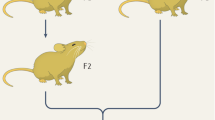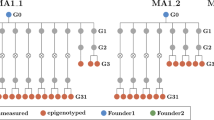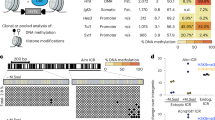Abstract
In mammals, imprinted genes have parent-of-origin–specific patterns of DNA methylation that cause allele-specific expression. At Rasgrf1 (encoding RAS protein-specific guanine nucleotide-releasing factor 1), a repeated DNA element is needed to establish methylation and expression of the active paternal allele1. At Igf2r (encoding insulin-like growth factor 2 receptor), a sequence called region 2 is needed for methylation of the active maternal allele2,3. Here we show that replacing the Rasgrf1 repeats on the paternal allele with region 2 allows both methylation and expression of the paternal copy of Rasgrf1, indicating that sequences that control methylation can function ectopically. Paternal transmission of the mutated allele also induced methylation and expression in trans of the normally unmethylated and silent wild-type maternal allele. Once activated, the wild-type maternal Rasgrf1 allele maintained its activated state in the next generation independently of the paternal allele. These results recapitulate in mice several features in common with paramutation described in plants4.
This is a preview of subscription content, access via your institution
Access options
Subscribe to this journal
Receive 12 print issues and online access
$209.00 per year
only $17.42 per issue
Buy this article
- Purchase on Springer Link
- Instant access to full article PDF
Prices may be subject to local taxes which are calculated during checkout




Similar content being viewed by others
References
Yoon, B.J. et al. Regulation of DNA methylation of Rasgrf1. Nat. Genet. 30, 92–96 (2002).
Birger, Y., Shemer, R., Perk, J. & Razin, A. The imprinting box of the mouse Igf2r gene. Nature 397, 84–88 (1999).
Sleutels, F., Zwart, R. & Barlow, D.P. The non-coding Air RNA is required for silencing autosomal imprinted genes. Nature 415, 810–813 (2002).
Brink, R.A. A genetic change associated with the R locus in maize which is directed and potentially reversible. Genetics 41, 872–889 (1956).
Plass, C. et al. Identification of Grf1 on mouse chromosome 9 as an imprinted gene by RLGS-M. Nat. Genet. 14, 106–109 (1996).
Pearsall, R.S. et al. A direct repeat sequence at the Rasgrf1 locus and imprinted expression. Genomics 55, 194–201 (1999).
Stoger, R. et al. Maternal-specific methylation of the imprinted mouse Igf2r locus identifies the expressed locus as carrying the imprinting signal. Cell 73, 61–71 (1993).
Lewis, E.B. The theory and application of a new method of detecting chromosomal rearrangements in Drosophila melanogaster. Am. Nat. 88, 225–239 (1954).
Kennison, J.A. & Southworth, J.W. Transvection in Drosophila. Adv. Genet. 46, 399–420 (2002).
Chandler, V.L., Eggleston, W.B. & Dorweiler, J.E. Paramutation in maize. Plant Mol. Biol. 43, 121–145 (2000).
Patterson, G.I., Thorpe, C.J. & Chandler, V.L. Paramutation, an allelic interaction, is associated with a stable and heritable reduction of transcription of the maize b regulatory gene. Genetics 135, 881–894 (1993).
Walker, E.L. Paramutation of the r1 locus of maize is associated with increased cytosine methylation. Genetics 148, 1973–1981 (1998).
Herman, J.G., Graff, J.R., Myohanen, S., Nelkin, B.D. & Baylin, S.B. Methylation-specific PCR: a novel PCR assay for methylation status of CpG islands. Proc. Natl. Acad. Sci. USA 93, 9821–9826 (1996).
Colot, V., Maloisel, L. & Rossignol, J.L. Interchromosomal transfer of epigenetic states in Ascobolus: transfer of DNA methylation is mechanistically related to homologous recombination. Cell 86, 855–864 (1996).
Stam, M., Belele, C., Dorweiler, J.E. & Chandler, V.L. Differential chromatin structure within a tandem array 100 kb upstream of the maize b1 locus is associated with paramutation. Genes Dev. 16, 1906–1918 (2002).
Hatada, I. et al. Aberrant methylation of an imprinted gene U2af1-rs1(SP2) caused by its own transgene. J. Biol. Chem. 272, 9120–9122 (1997).
Forne, T. et al. Loss of the maternal H19 gene induces changes in Igf2 methylation in both cis and trans. Proc. Natl. Acad. Sci. USA 94, 10243–10248 (1997).
Rassoulzadegan, M., Magliano, M. & Cuzin, F. Transvection effects involving DNA methylation during meiosis in the mouse. EMBO J. 21, 440–450 (2002).
LaSalle, J.M. & Lalande, M. Homologous association of oppositely imprinted chromosomal domains. Science 272, 725–728 (1996).
Bennett, S.T. et al. Insulin VNTR allele-specific effect in type 1 diabetes depends on identity of untransmitted paternal allele. The IMDIAB Group. Nat. Genet. 17, 350–352 (1997).
Lewandoski, M., Wassarman, K.M. & Martin, G.R. Zp3-cre, a transgenic mouse line for the activation or inactivation of loxP-flanked target genes specifically in the female germ line. Curr. Biol. 7, 148–151 (1997).
de la Puente, A. et al. Structural characterization of Rasgrf1 and a novel linked imprinted locus. Gene 291, 287–297 (2002).
Acknowledgements
The authors thank D. Barlow for the Igf2r region 2 clone, G. Martin for Zp3-cre mice and M. Stam and V.L. Chandler for helpful comments and sharing unpublished data. This work was supported by grants to P.D.S. from the US National Eye Institute, US National Cancer Institute, US Department of Defense and the Roswell Park Alliance and by a US National Cancer Institute Core Grant to Roswell Park Cancer Institute.
Author information
Authors and Affiliations
Corresponding author
Ethics declarations
Competing interests
The authors declare no competing financial interests.
Rights and permissions
About this article
Cite this article
Herman, H., Lu, M., Anggraini, M. et al. Trans allele methylation and paramutation-like effects in mice. Nat Genet 34, 199–202 (2003). https://doi.org/10.1038/ng1162
Received:
Accepted:
Published:
Issue Date:
DOI: https://doi.org/10.1038/ng1162
This article is cited by
-
Genetic control of non-genetic inheritance in mammals: state-of-the-art and perspectives
Mammalian Genome (2020)
-
Paramutation and related phenomena in diverse species
Nature Reviews Genetics (2017)
-
Epigenetic inheritance of acquired traits through sperm RNAs and sperm RNA modifications
Nature Reviews Genetics (2016)
-
Parental and sexual conflicts over the Peg3 imprinted domain
Scientific Reports (2016)
-
Mammalian recombination hot spots: properties, control and evolution
Nature Reviews Genetics (2010)



